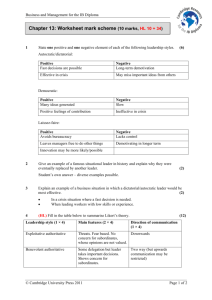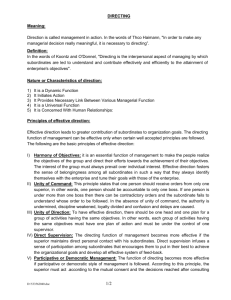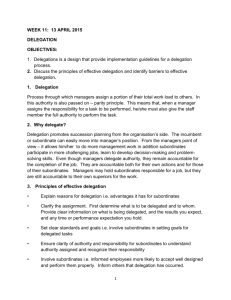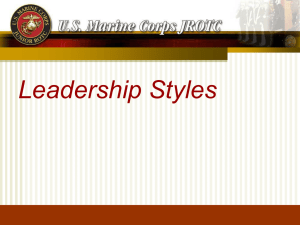Management and leadership
advertisement
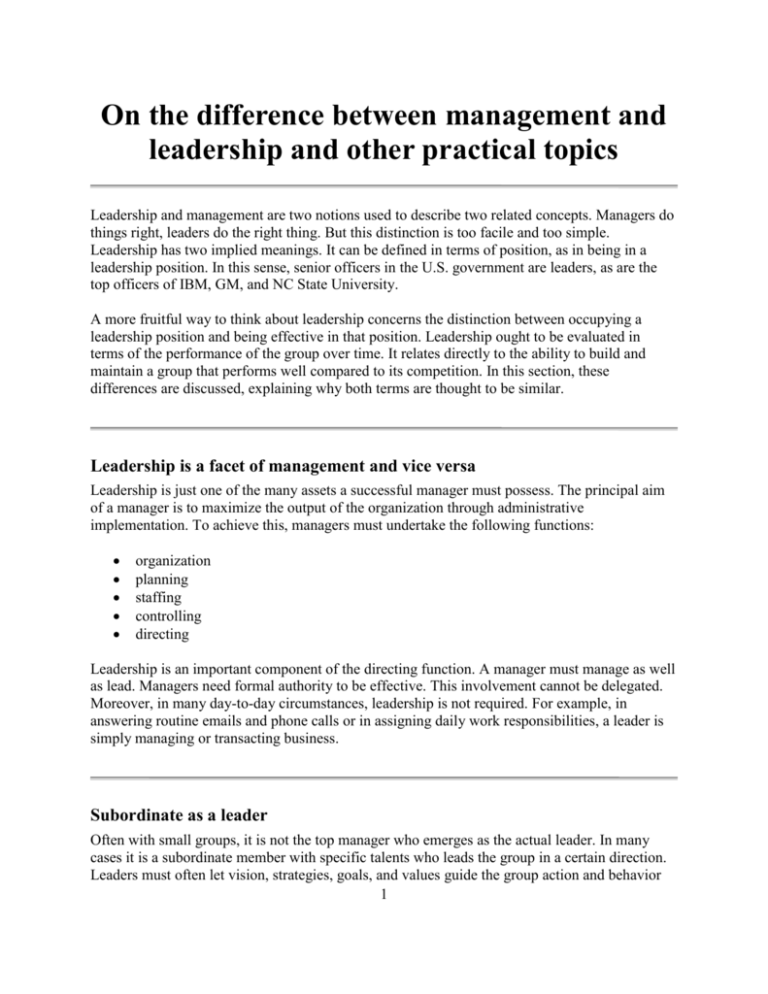
On the difference between management and leadership and other practical topics Leadership and management are two notions used to describe two related concepts. Managers do things right, leaders do the right thing. But this distinction is too facile and too simple. Leadership has two implied meanings. It can be defined in terms of position, as in being in a leadership position. In this sense, senior officers in the U.S. government are leaders, as are the top officers of IBM, GM, and NC State University. A more fruitful way to think about leadership concerns the distinction between occupying a leadership position and being effective in that position. Leadership ought to be evaluated in terms of the performance of the group over time. It relates directly to the ability to build and maintain a group that performs well compared to its competition. In this section, these differences are discussed, explaining why both terms are thought to be similar. Leadership is a facet of management and vice versa Leadership is just one of the many assets a successful manager must possess. The principal aim of a manager is to maximize the output of the organization through administrative implementation. To achieve this, managers must undertake the following functions: organization planning staffing controlling directing Leadership is an important component of the directing function. A manager must manage as well as lead. Managers need formal authority to be effective. This involvement cannot be delegated. Moreover, in many day-to-day circumstances, leadership is not required. For example, in answering routine emails and phone calls or in assigning daily work responsibilities, a leader is simply managing or transacting business. Subordinate as a leader Often with small groups, it is not the top manager who emerges as the actual leader. In many cases it is a subordinate member with specific talents who leads the group in a certain direction. Leaders must often let vision, strategies, goals, and values guide the group action and behavior 1 rather than attempting to control others. When a natural leader emerges in a group containing a manager, conflict may arise if they have different views. When a manager sees the group looking towards someone else for leadership he may feel his authority is being questioned. Loyalty Groups are often more loyal to a leader than a manager. This loyalty is created by the leader in areas such as: Taking the blame when things go wrong. Celebrating group achievements, even minor ones. Giving credit where it is due. The leader should recognize the successes within a team. Leaders are observant and sensitive people. They know their team and develop mutual confidence within it. Conclusion Managing and leading are related activities. All managers lead some of the time. Individuals at the top of organizations, normally considered “leaders,” have to manage on a daily basis. Top managers (e.g., CEOs or executive vice presidents) are generally viewed by subordinates and the public in a different way from line managers. This is primarily because of the level of responsibility: top managers like CEOs spend more of their time on strategy, wide-ranging communication across the organization, and in “regal” functions. Line (or lower-level) managers typically are involved in more direct functional activities (marketing, production, finance, HR) and less concerned with the broader functions associated with “leaders.” Contingency Models Leadership styles cannot be fully explained by behavioral models. The situation in which the group is operating also determines the style of leadership which is adopted. Several models exist which attempt to understand the relationship between style and situation, four of which are described here: Fiedler's Contingency Model. Hersey-Blanchard Situational Theory. 2 Path-Goal Theory. Vroom-Yetton Leadership Model The models described have limited utility, but are still widely accepted in the leadership literature. Fiedler's Contingency model Fiedler's model assumes that group performance depends on: Leadership style, described in terms of task motivation and relationship motivation. Situational favorableness, determined by three factors: 1. Leader-member relations - Degree to which a leader is accepted and supported by the group members. 2. Task structure - Extent to which the task is structured and defined, with clear goals and procedures. 3. Position power - The ability of a leader to control subordinates through reward and punishment. High levels of these three factors give the most favorable situation; low levels, the least favorable. Relationship-motivated leaders are most effective in moderately favorable situations. Task-motivated leaders are most effective at either end of the scale. Fiedler suggests that it may be easier for leaders to change their situation to achieve effectiveness, rather than change their leadership style. Hersey-Blanchard situational theory This theory suggests that leadership style should be matched to the maturity of the subordinates. Maturity is assessed in relation to a specific task and has two parts: Psychological maturity - Their self-confidence and ability and readiness to accept responsibility. Job maturity - Their relevant skills and technical knowledge. As the subordinate maturity increases, leadership should be more relationship-motivated than task-motivated. For four degrees of subordinate maturity, from highly mature to highly immature, leadership can consist of: Delegating to subordinates. Participating with subordinates. 3 Selling ideas to subordinates. Telling subordinates what to do Path-Goal Theory Evans and House suggest that the performance, satisfaction and motivation of a group can be affected by the leader in a number of ways: Offering rewards for the achievement of performance goals. Clarifying paths towards these goals. Removing performance obstacles. A person may do these by adopting a certain leadership style, according to the situation: Directive leadership - Specific advice is given to the group and ground rules are established. Supportive leadership - Good relations exist with the group and sensitivity to subordinates' needs is shown. Participative leadership - Decision making is based on group consultation and information is shared with the group. Achievement-oriented leadership - Challenging goals are set and high performance is encouraged while showing confidence in the groups' ability. Supportive behavior increases group satisfaction, particularly in stressful situations, while directive behavior is suited to ambiguous situations. It is also suggested that leaders who have influence upon their superiors can increase group satisfaction and performance. Vroom-Yetton Leadership Model This model suggests the selection a leadership style for making a decision. There are five decision making styles: Autocratic 1 - Problem is solved using information already available. Autocratic 2 - Additional information is obtained from group before leader makes decision. Consultative 1 - Leader discusses problem with subordinates individually, before making a decision. Consultative 2 - Problem is discussed with the group before deciding. Group 2 - Group decides upon problem, with leader simply acting as chair. 4 The style is chosen by the consideration of seven questions, which form a decision tree. This is described in Leadership and Decision Making, by V.H.Vroom and P.W.Yetton, pp.41-42, published by University of Pittsburgh Press, 1973. Leadership Styles The role of leadership in management is largely determined by the organizational culture of the company. It has been argued that managers' beliefs, values, and assumptions are critical to the overall style of leadership they adopt. There are several different leadership styles that can be identified within each of the following management techniques. Each has its own set of good and not-so-good characteristics, and each uses leadership in a different way. The autocrat The autocratic leader dominates team-members, using unilateralism to achieve a singular objective. This approach to leadership generally results in passive resistance from team-members and requires continual pressure and direction from the leader in order to get things done. Generally, an authoritarian approach is not a good way to get the best performance from a team. There are, however, some instances where an autocratic style of leadership may not be inappropriate. Some situations may call for urgent action, and in these cases an autocratic style of leadership may be best. In addition, most people are familiar with autocratic leadership and therefore have less trouble adopting that style. Furthermore, in some situations, sub-ordinates may actually prefer an autocratic style. The laissez-faire manager The Laissez-Faire manager exercises little control over his group, leaving them to sort out their roles and tackle their work, without participating in this process himself. In general, this approach leaves the team floundering with little direction or motivation. Again, there are situations where the Laissez-Faire approach can be effective. The Laissez-Faire technique is usually only appropriate when leading a team of highly motivated and skilled people, who have produced excellent work in the past. Once a leader has established that his team is confident, capable and motivated, it is often best to step back and let them get on with the task, since interfering can generate resentment and detract from their effectiveness. By handing over ownership, a leader can empower his group to achieve their goals. 5 The democrat The democratic leader makes decisions by consulting his team, whilst still maintaining control of the group. The democratic leader allows his team to decide how the task will be tackled and who will perform which task. The democratic leader can be seen in two lights: A good democratic leader encourages participation and delegates wisely, but never loses sight of the fact that he bears the crucial responsibility of leadership. He values group discussion and input from his team and can be seen as drawing from a pool of his team members' strong points in order to obtain the best performance from his team. He motivates his team by empowering them to direct themselves, and guides them with a loose reign. However, the democrat can also be seen as being so unsure of himself and his relationship with his sub-ordinates that everything is a matter for group discussion and decision. Clearly, this type of "leader" is not really leading at all. Leadership Attitudes Another way of looking at different leadership styles is in terms of task orientation versus employee orientation. Task Orientation or Directive Behavior. This reflects how much a leader is concerned with the actual task at hand and ensuring that those following him complete it. Employee Orientation or Supportive Behavior. This reflects how much a leader is concerned for the people around him, providing support and encouragement for them. The combination of these two effects leads to the following diagram: 1. Country Club Management 2. SUPPORTING 1. Impoverished Management 2. DELEGATING 1. Team Management 2. COACHING 1. Authority/Obedience Management 2. DIRECTING This diagram can be used in two ways: As a guide to how effective your leadership style is. Your general attitude to the leadership of the group will fall into one of these categories. As a guide to how best to lead different individuals using different styles to make the most efficient use of both their, and your, time and talents. 6 Analyzing your style How do you lead your group? What is your attitude to both them and the task at hand? Impoverished Management (low concern for the task, low concern for people). This style is characterized by minimal effort on your part, just enough to get the job done and maintain the group structure. "I'll just let them get on with it, I'm sure they'll do fine, they don't really want me interfering anyway" Country Club Management (low concern for the task, high concern for people). You take good care of your group, ensuring a comfortable, friendly atmosphere. You hope this will lead to the work getting done. "It stands to reason, if they're happy they'll work harder and the work will take care of itself." Authority/Obedience Management (high concern for task, low concern for people). You are probably a bit of a task master. The most important thing is the work. You lead from behind by driving the group in front of you. "We're here to work, the work needs to be done. If they're working hard enough they won't have time to feel unhappy, they're not here to enjoy themselves." Team Management (high concern for task, high concern for people). You see the completion of the task and the well being of the group as interdependent through a common stake in the organization's future. This leads to relationships built on trust and respect, and work accomplishment from committed employees. "We're in this together. We need to support and help each other to get this job done." It is generally accepted that group leaders who have a Team Management style are the most effective, though this is not always the case. Style choice If you have a group of widely differing levels of ability, confidence, and commitment, you might want to lead them each with a different style. Directing A team member who has a lot of enthusiasm for the job but not much actual ability, for example a new start, will need to be directed. You will not need to spend much time giving encouragement or coaxing them along. You will however have to tell them what to do next after they complete every task, and how to do the tasks set. Coaching After being in the group for a while, somebody might begin to lose confidence and therefore motivation, as they still can't seem to do the work they want to do. At this stage you will need to coach them along. You will still need to tell them what to do at virtually 7 every point along the way, while taking care to encourage them and praise them at every turn. Supporting Gradually the team member's technical ability will increase until they are at a stage where they can actually do everything required of them, however they may still lack the confidence to actually do it off their own backs. You should no longer have to tell them what to do, although they may think otherwise. You should seek their opinions on the next stage, and be seen to take notice of their ideas. Delegating A technically competent person's confidence will gradually grow until they feel able to work completely on their own. You should now be able to delegate specific areas of work to them and feel little need to tell them either what to do or to praise them as frequently for doing it. The time that you don't have to spend "leading" these members of the group can be spent with the less experienced group members, or on the work that you need to do. Delegation "I not only use all the brains I have, but all I can borrow." - Woodrow Wilson A key aspect of leadership is delegation. If leaders don’t delegate tasks to subordinates, teams might quickly become inefficient and demoralized. Poor Delegation Signs that you are not borrowing enough brains or that your delegation is failing include: Team Motivation / Morale is down You are always working late Your team is confused / conflicting / tense You get questions about delegated tasks too often Not delegating a task because you think that you would do it better than anyone else is a poor excuse. Doing this might make life difficult for yourself. Advantages of delegation Positive aspects of delegation include: Higher efficiency 8 Increased motivation Develops the skills of your team Better distribution of work through the group How to delegate 1. Identify a suitable person for the task. 2. Prepare the person. Explain the task clearly. Make sure that you are understood. Leave room in the task description for ingenuity / initiative. 3. Make sure the person has the necessary authority to do the job properly. 4. Keep in touch with the person for support and monitoring progress. Do not get to close. Accept alternative approaches. 5. Praise / Acknowledge a job well done. Responsibility Even though you have delegated a task to someone else, you are still responsible for making sure the task is done on time and correctly. If the task fails, you can not point the finger. You delegated. It is your fault. You may have picked the wrong person for the job. Authority The amount of authority you delegate is up to you, although it should be enough to complete the task. It is no good giving Bob the task of opening the safe every morning at 10am if you do not give him the authority required to do it. Bob needs the key to open the safe with. Tasks you should not delegate Obviously some aspects of leadership are sensitive and should not be delegated. For example: Hiring Firing Pay issues Policy Your task after delegating After delegating: 9 Plan - goals, meeting, tasks Direct - your team, keep them on track Encourage - boost morale Practical aspects of directing teams When directing a small team it is important to structure the tasks to be performed. Goals should be easily understood by everyone and tasks broken down so that they appear achievable. Break down the task Nothing will be more demoralizing for your team than setting them a task that seems impossible (the brick wall approach). Therefore, it is important to define a task as a series of small but significant steps which seem realistic. As the person performs these broken-down steps he/she will feel something tangible has been accomplished. The next step toward finishing will become clear. The brick wall approach will usually result in the task not being accomplished. Goal analysis It is probable that as a team leader you will want to set goals for your team or project. One such goal may be "to improve communications amongst the team". Clearly there will be many different interpretations of this goal by different team members. Goal analysis seeks to remove this ambiguity. Goal analysis should define an abstract goal in terms of concrete criteria, which when met will clearly demonstrate that the goal has been achieved. The criteria should be expressed in terms of actions or results rather than abstractions (which may be ambiguous). There are 5 steps: 1) Write down the goal. At this stage the goal is an abstract thing, and it is important not to worry too much about how the goal is written down - a rough definition or idea will suffice. 2) Without editing or judging - describe the goal. Get team members to quickly describe what they understand by the goal. At this stage all suggestions should be noted down - no ideas are wrong or stupid. This is similar to the technique of brainstorming. 10 3) Sort. Sort out the ideas generated by 2 into an ordered or prioritized list which defines the goal. At this stage it may become apparent that some ideas are abstractions but are still important. If this is the case use steps 1 and 2 to clearly define these. 4) State each action or result obtained from 3. Make the team read and try to understand the list from step 3. 5) Test the statements. Ask the question - "When these all statements have been demonstrated to be true, will the goal have been achieved?" Test each statement in turn for relevance. If the answer is yes then the goal has been defined. Keeping the team together Introduction One function that a leader of a team must perform is holding the team together. A leader is responsible for: ensuring project goals are met ensuring a full team effort keeping the team happy Motivation The key to holding the team together is motivation. To motivate is to: "cause (person) to act in a particular way; stimulate interest of (person in activity)." In simple terms, motivation can be considered as the amount of effort an individual is willing to put into their work. Therefore, it is important to ensure that any team is highly motivated towards their work. A lack of motivation in any member of a team can have a negative affect, reducing the group's effectiveness and possibly leading to the de-motivation of others. Given the fact that different people are motivated in different ways, the problem facing someone in the role of leader is to create an environment in which each individual fulfils their potential. It is important to highlight the major influences in the motivation of people. According to the influential motivator-hygiene theory, motivation occurs when people have job satisfaction. Job satisfaction can be improved by increasing opportunities for: Achievement Recognition 11 Responsibility Career advancement While not increasing job satisfaction, improvements in the following areas can lessen job dissatisfaction: Supervision Salary Working conditions Six Steps to motivation The following steps can be taken to help achieve and maintain group motivation: Provide opportunities for group members to become acquainted. Indicate the importance/value of the group. Make people feel they are important. Clarify goals. Identify progress. Acknowledge achievements. Disputes Inevitably, disputes ranging from minor differences in opinion, to fundamental differences in ideology, will arise. The role of the team leader is to handle such disagreements constructively, ensuring that the team remains focused on achieving its goal. The leader must encourage team members to stand back from any disagreements and look at things objectively. By doing this, any differences between group members will be resolved and possible conflicts avoided. A win-win approach (as opposed to win-lose) typically works best in dealing with conflicts. Conclusion The most important point for a team leader to remember is that each individual needs to think that they are working with the best people—to feel proud to be part of the team. By getting people into this state of mind, a leader will instill a high level of group morale. Research shows people in these conditions will work harder and achieve more. 12
